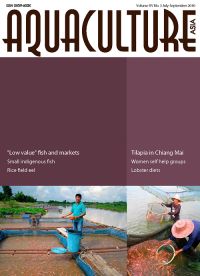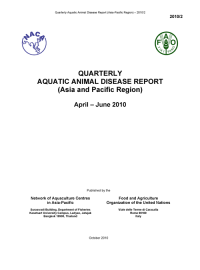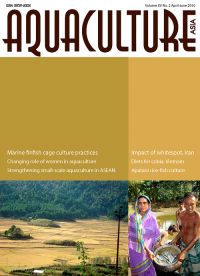In this issue:
Relative efficacies of lobsters Panulirus ornatus and P. homarus cultured using pellet feeds and trash fish, Vietnam. Tilapia in Chiang Mai, Thailand. Marketing low-value cultured fish in Bangladesh: An evaluation of value chain. Current practices of rice field eel Monopterus albus culture in Vietnam. Self-help group makes fisherwomen self-relian: A story of success. Small indigenous freshwater fish species of India: Significance, conservation and utilisation.
In this issue:
Vietnamese catfish - better management practices update. Is this the perfect prawn? Fish Oil Replacement and Alternative Lipid Sources in Aquaculture Feeds. Multilingual CD-ROM of FAO cultured aquatic species fact sheets. Aquaclimate Annual Progress Report 2010. Training course on application of business management principles in small-scale aquaculture.
In this issue:
The Dedanaw Project, Myanmar. The changing face of women for small-scale aquaculture in Bangladesh. Strengthening capacity of small holders in ASEAN. Carp seed production in Orissa, India. Sustainable mountain paddy-fish farming of the Apatani tribes. The economic impacts of whitespot virus on shrimp production in Iran. Current practices of marine finfish cage culture in China, Indonesia, Thailand and Vietnam. Effects of trash fish on growth and body composition of cobia.
In this issue:
Expert Workshop on Inland Fisheries Resource Enhancement and Conservation in Asia. Reviews in Aquaculture: Special issue on the Use and Exchange of Aquatic Genetic Resources. Dr Ayyappan becomes the Director General of ICAR. CIBA training course - capacity building on entrepreneurship development in coastal aquaculture. Success Stories in Asian Aquaculture - now available for free download! Giant Prawn 2011. Peer reviewed publications. Meetings address climate change impacts on small scale milkfish farmers in the Philippines.




